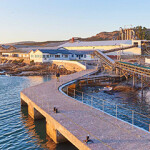Sustainability of New Zealand orange roughy in question before annual MSC audit

History seems to be repeating itself within New Zealand’s orange roughy fisheries, as new science calls the species’ management into question.
In the 1980s, stocks of the species in the country suffered from overfishing due to faulty assumptions about its growth rate and productivity. Better science and management resulted in a rebound of the species, with three New Zealand orange roughy fisheries eventually receiving Marine Stewardship Council (MSC) certification in 2016.
Now, research indicates that stock assessments and catch limits may have been relying on unsound assumptions about the proper breeding age for the species.
A population assessment in one of New Zealand’s orange roughy fisheries found breeding ages for the species are much higher than those used to calculate previous assessments. Just 50 percent of stocks in the populations assessed spawned by 55 years old, and it was not until the age of 73 that 95 percent of the stock was breeding.
The three MSC-certified New Zealand orange roughy fisheries achieved recertification in 2022, despite concerns raised by conservation organizations regarding the implications of resarch on the species’s reproductive cycle.
A review of sustainability measures published by Fisheries New Zealand, an office of the New Zealand Ministry for Primary Industries, said the previous stock assessment of the East and South Chatham Rise substock was rejected after it was found to "no longer be considered to accurately reflect stock status."
"A new stock assessment was not able to be completed, and the current status of the ESCR substock is unknown,” it said.
In other words, New Zealand has withdrawn all stock assessments for the main substock of the deepwater species, which comprises around 70 percent of the MSC-labeled orange roughy from New Zealand.
“It seems that the more that is [discovered] about orange roughy, the less that is known or understood,” Royal Forest and Bird Protection Society Fisheries Scientist Barry Weeber told SeafoodSource. “Issues that need to be addressed include past aging, skipped annual spawning, and changes in maturity. There is [also] the issue of lost spawning aggregations that have not returned. There is much uncertainty that needs to be worked through before a new assessment is completed.”
Complicating the issue further, the MSC has an annual audit scheduled for October 2023. Without an assessment in place, the MSC may end up ...
Photo courtesy of CSRIO




Share